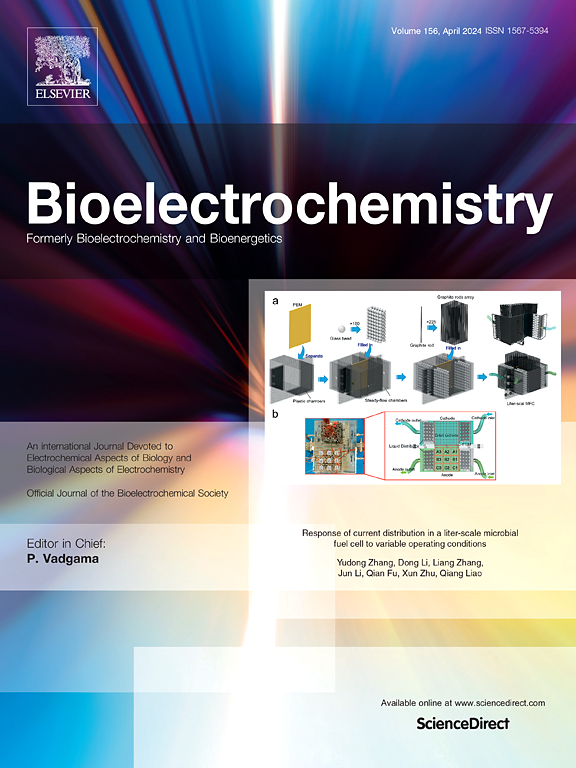High-frequency irreversible electroporation suppresses invasion and metastasis by targeting SIRT1/2 in highly invasive tumor cells: an in vitro study
IF 4.5
2区 化学
Q1 BIOCHEMISTRY & MOLECULAR BIOLOGY
引用次数: 0
Abstract
Sirtuin proteins have key roles in cancer progression and metastases. However, their role in bioelectrical modulation via high-frequency irreversible electroporation (H-FIRE) remains poorly defined. This study aims to investigate the molecular mechanism by which H-FIRE suppresses invasion and metastasis in highly invasive cancer cells (U87 and U2OS) through SIRT1/2 downregulation. We systematically assessed H-FIRE effects on cell proliferation, clonogenicity, invasion, metastasis, apoptosis, mitochondrial morphology, and SIRT1/2 expression. Our results demonstrated that H-FIRE significantly suppressed proliferation, invasion, and metastasis in both two cell lines, concurrently inducing mitochondrial fragmentation and apoptosis. Crucially, H-FIRE markedly downregulated SIRT1/2 expression. Notably, SIRT activators partially reversed H-FIRE-mediated invasion suppression, whereas SIRT inhibitors enhanced inhibitory effect. These results underscore that H-FIRE impedes the invasion and metastasis of highly invasive tumor cells through inhibition of SIRT1/2 expression and induction of mitochondrial apoptosis. Our findings establish SIRT1/2 as critical molecular targets mediating the anti-metastatic effect of H-FIRE and support its potential as an anti-metastatic therapy.
高频不可逆电穿孔通过靶向SIRT1/2抑制高侵袭性肿瘤细胞的侵袭和转移:一项体外研究
Sirtuin蛋白在癌症进展和转移中起关键作用。然而,它们通过高频不可逆电穿孔(H-FIRE)在生物电调制中的作用仍然不明确。本研究旨在探讨H-FIRE通过下调SIRT1/2抑制高侵袭性癌细胞(U87和U2OS)侵袭转移的分子机制。我们系统地评估了H-FIRE对细胞增殖、克隆原性、侵袭、转移、凋亡、线粒体形态和SIRT1/2表达的影响。我们的研究结果表明,H-FIRE显著抑制两种细胞系的增殖、侵袭和转移,同时诱导线粒体断裂和凋亡。关键是,H-FIRE显著下调SIRT1/2的表达。值得注意的是,SIRT激活剂部分逆转了h - fire介导的侵袭抑制,而SIRT抑制剂增强了抑制作用。这些结果表明,H-FIRE通过抑制SIRT1/2的表达和诱导线粒体凋亡来阻止高侵袭性肿瘤细胞的侵袭和转移。我们的研究结果证实SIRT1/2是介导H-FIRE抗转移作用的关键分子靶点,并支持其作为抗转移治疗的潜力。
本文章由计算机程序翻译,如有差异,请以英文原文为准。
求助全文
约1分钟内获得全文
求助全文
来源期刊

Bioelectrochemistry
生物-电化学
CiteScore
9.10
自引率
6.00%
发文量
238
审稿时长
38 days
期刊介绍:
An International Journal Devoted to Electrochemical Aspects of Biology and Biological Aspects of Electrochemistry
Bioelectrochemistry is an international journal devoted to electrochemical principles in biology and biological aspects of electrochemistry. It publishes experimental and theoretical papers dealing with the electrochemical aspects of:
• Electrified interfaces (electric double layers, adsorption, electron transfer, protein electrochemistry, basic principles of biosensors, biosensor interfaces and bio-nanosensor design and construction.
• Electric and magnetic field effects (field-dependent processes, field interactions with molecules, intramolecular field effects, sensory systems for electric and magnetic fields, molecular and cellular mechanisms)
• Bioenergetics and signal transduction (energy conversion, photosynthetic and visual membranes)
• Biomembranes and model membranes (thermodynamics and mechanics, membrane transport, electroporation, fusion and insertion)
• Electrochemical applications in medicine and biotechnology (drug delivery and gene transfer to cells and tissues, iontophoresis, skin electroporation, injury and repair).
• Organization and use of arrays in-vitro and in-vivo, including as part of feedback control.
• Electrochemical interrogation of biofilms as generated by microorganisms and tissue reaction associated with medical implants.
 求助内容:
求助内容: 应助结果提醒方式:
应助结果提醒方式:


